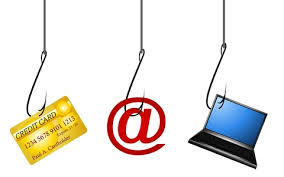As in anything in life, there is good...but, unfortunately, there is also bad. So it is in the "tech" world. There have been so many "lightening fast" advancements in this industry..that definitely is the good part, but the "law" has had trouble keeping up with these advancements. Consequently, we have basically a "Wild West" situation that can affect corporate and personal alike...with a possible devastating outcome.
Terms like "Identity Theft", and "Cyber Criminals" are part of our everyday vocabulary now. Here is another term that I feel is imperative with which to become familiar..."PHISHING"
The definition of "Phishing" is...the activity of defrauding an online account holder of financial information by posing as a legitimate company.
Phishing email messages, websites, and phone calls are designed to steal money. Cybercriminals can do this by installing malicious software on your computer or stealing personal information off of your computer.
Cybercriminals also use social engineering to convince you to install malicious software or hand over your personal information under false pretenses. They might email you, call you on the phone, or convince you to download something off of a website.
One of the most common ways Cybercriminals conduct a "phishing expedition" is through email activity. However, if you are diligent, there are ways to spot fraudulent schemes. Here are some examples...
- Spelling and bad grammar. Cybercriminals are not known for their grammar and spelling. Professional companies or organizations usually have a staff of copy editors that will not allow a mass email like this to go out to its users. If you notice mistakes in an email, it might be a scam.
- Beware of links in email. If you see a link in a suspicious email message, don't click on it. Rest your mouse (but don't click) on the link to see if the address matches the link that was typed in the message. In the example below the link reveals the real web address, as shown in the box with the yellow background. The string of cryptic numbers looks nothing like the company's web address.
Links might also lead you to .exe files. These kinds of file are known to spread malicious software.
- Threats. Have you ever received a threat that your account would be closed if you didn't respond to an email message? The email message shown above is an example of the same trick. Cybercriminals often use threats that your security has been compromised.
- Spoofing popular websites or companies. Scam artists use graphics in email that appear to be connected to legitimate websites but actually take you to phony scam sites or legitimate-looking pop-up windows.
Cybercriminals also use web addresses that resemble the names of well-known companies but are slightly altered.
Cybercriminals might call you on the phone and offer to help solve your computer problems or sell you a software license. Legitimate companies do not make unsolicited phone calls (also known as cold calls) to charge you for computer security or software fixes.
Once the scam artist has gained your trust, they might ask for your user name and password or ask you to go to a website to install software that will let them access your computer to fix it. Once you do this, your computer and your personal information is vulnerable.
Treat all unsolicited phone calls with skepticism. Do not provide any personal information.
If you receive a fake phone call, take down the caller's information and report it to your local authorities.
If you are a business owner, and you feel it would be simpler and safer to have I.T. experts handle this for you, contact us for a free consultation. We offer Email and Spam protection as part of our wide array of services and we welcome the opportunity to chat with you.


